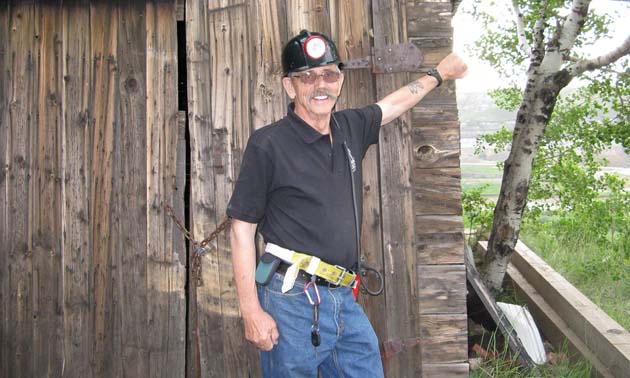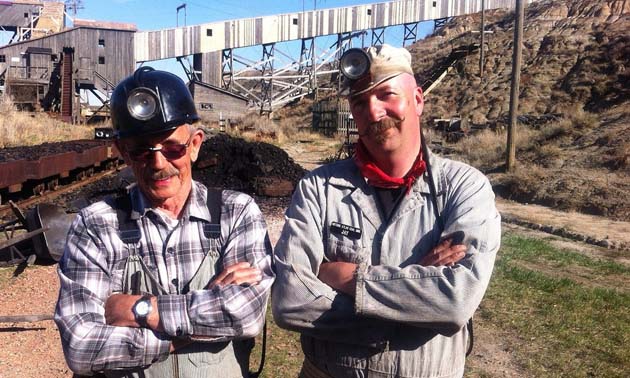Bob Moffatt: A pioneer of Canada’s energy sector
As a fifth-generation coal miner, Moffatt now runs tours at the preserved Atlas Coal Mine in Drumheller, Alberta

Bob Moffatt is a fifth-generation coal miner who began his career at the Atlas Coal Mine in Drumheller, Alberta. Decades later, he's returned to share his experience at the preserved historical site. — Photo: Marg Meisner
Bob Moffatt began working at the Atlas Coal Mine in Drumheller, Alberta, at the age of 16. In its heyday, the Atlas Coal Mine was one of Drumheller’s largest producers. Now, Atlas is an historical site with the original preserved buildings and artifacts.
Daily life looks a little different from the first time Moffatt worked at the mine. “I started working in the tipple. I just about froze to death up there. It was about 40 to 45 degrees below in those days,” he said. “Then I went underground where I drove ponies, operated locomotives. I had a number of jobs.”
It was common for families to work together in the mines, and to begin at an early age. Age 16 doesn’t seem so young when Moffatt tells stories of his grandfather: “My grandfather was eight. My dad was 14.” His great-grandfather actually lied about his grandfather’s age so he could start working early—the minimum age to work in the mines was 10 at the time. The average 16-hour days at the mine often ended with his great-grandfather carrying his son home to bed.
Working in the mines of the Drumheller Valley was a dangerous job. “You got used to it, and you lived with the fact that you might not be here tomorrow, but you don’t think about that,” he said. Making light of the situation, Moffatt said he thought that working underground was at least better than his first job manning the tipple outside. “Boy, did that beat 40 below outside, and the wages were better.”
Drumheller’s mines were the livelihood of the West. “This part of the world would not have been settled if they didn’t find coal,” he said. As the mines around Drumheller began to close, Moffat moved onto other areas of the energy industry. Although he was offered positions at the last couple of mines in the valley, the work was no longer lucrative. At that point, they “only worked four or five months of the year.” Coal was no longer king.
Despite the conditions, Moffatt always thought his work in the mines was a pretty good deal. “If the mine work was steady, I never would have left the mines. I would have stayed until I retired. As a contract miner, you made as much as you wanted to, you worked as hard as you wanted to. It was a production.” When oil became the king of the West, he moved onto the rigs. “I felt safer in the mines than on the rigs.” The mines were a well-oiled working machine, where each man could work as much as he wanted. Accidents happened, but fellow miners helped each other out of tricky situations. The early days of the rigs attracted a different breed of workers.
Moffatt’s career took him elsewhere for a few years, but he was born and raised in Drumheller. It was only a matter of time before he returned to the valley. “I heard they were doing tours out at the mine. I came to the mine, and took a tour,” he said. “The misinformation that came out of that poor guy’s mouth was very bad.” Moffatt offered to help train the tour guides with the goal of correcting and strengthening their stories.
Now, Moffatt runs tours at Atlas. As a fifth-generation coal miner, Moffatt has collected stories from his grandfather, his father, and his own experiences in the mine. “I just love it here,” he said. Aside from his role as the resident historical figure at Atlas Coal Mine, Moffatt also maintains the site. His first order of duty was to return the old locomotive to its original working form, but his duties progressed over time. As someone who was trained and actually worked on the site, he knows a lot about how to keep things running up to par for visitors. For example, he regularly inspects the tunnels for the underground tours. “I’m qualified to replace timbers and booms in there.”

Bob Moffatt and Jay Russel, Executive Director at Atlas Coal Mine, pose in mining clothes on the site. — Photo: Marg Meisner
On his tours, Moffatt attaches real stories and real people to the artifacts that remain on the site. He knows who worked where, and always has a new tale to tell. “I give them a history of mining through the years and how things improved,” he said. “I like when people aren’t afraid to ask questions.” His favourite stories are the ones that people find hard to believe. “I like to see their eyes light up, like you’ve got to be kidding—but I’m not.”
“It’s the same as the army,” Moffatt said of the work in the coal mines. “I just went down there. It was a good job as far as I was concerned.” The history of the Atlas Coal Mine brought him back after decades away, but at least the work conditions now are a little more appealing.




